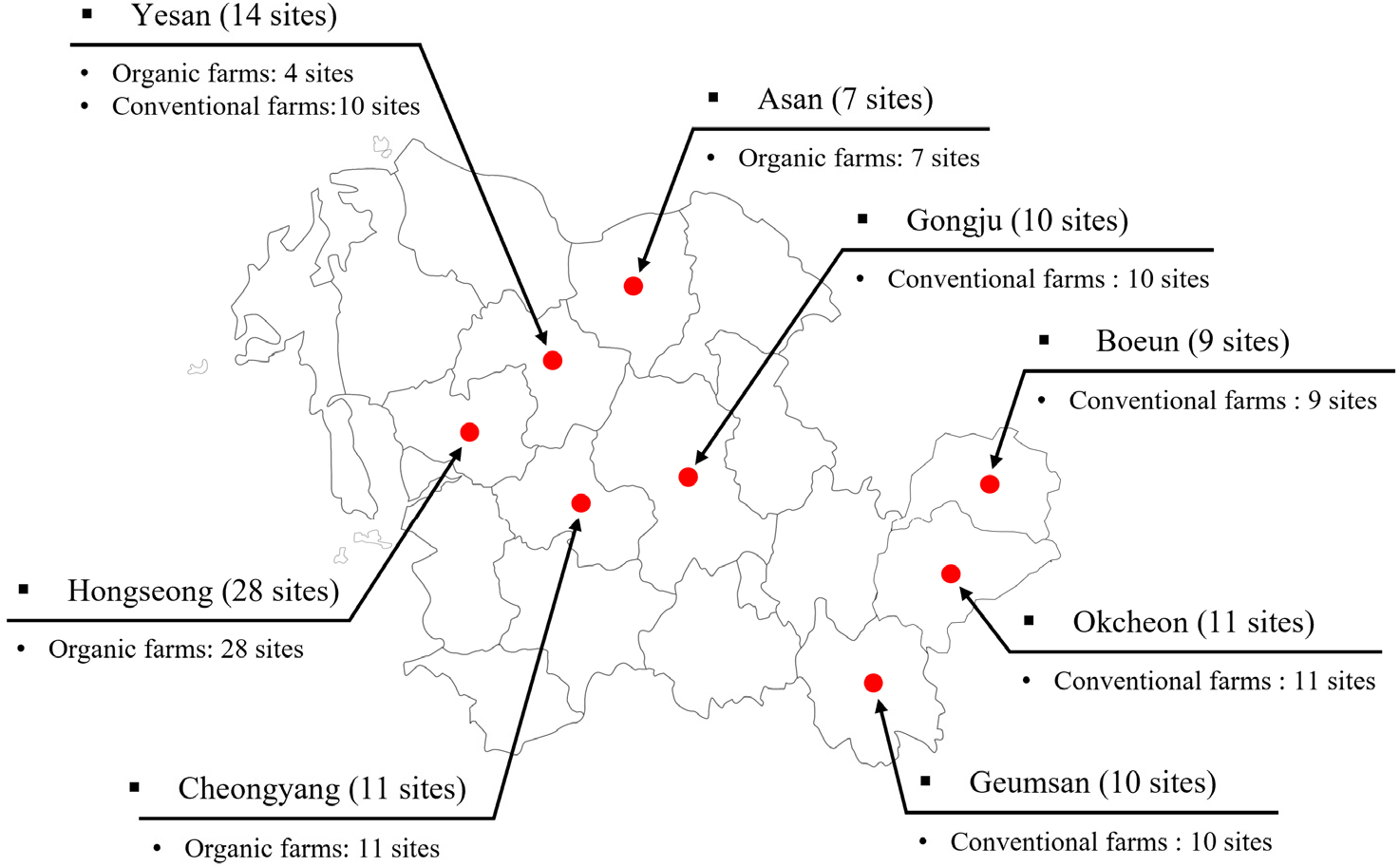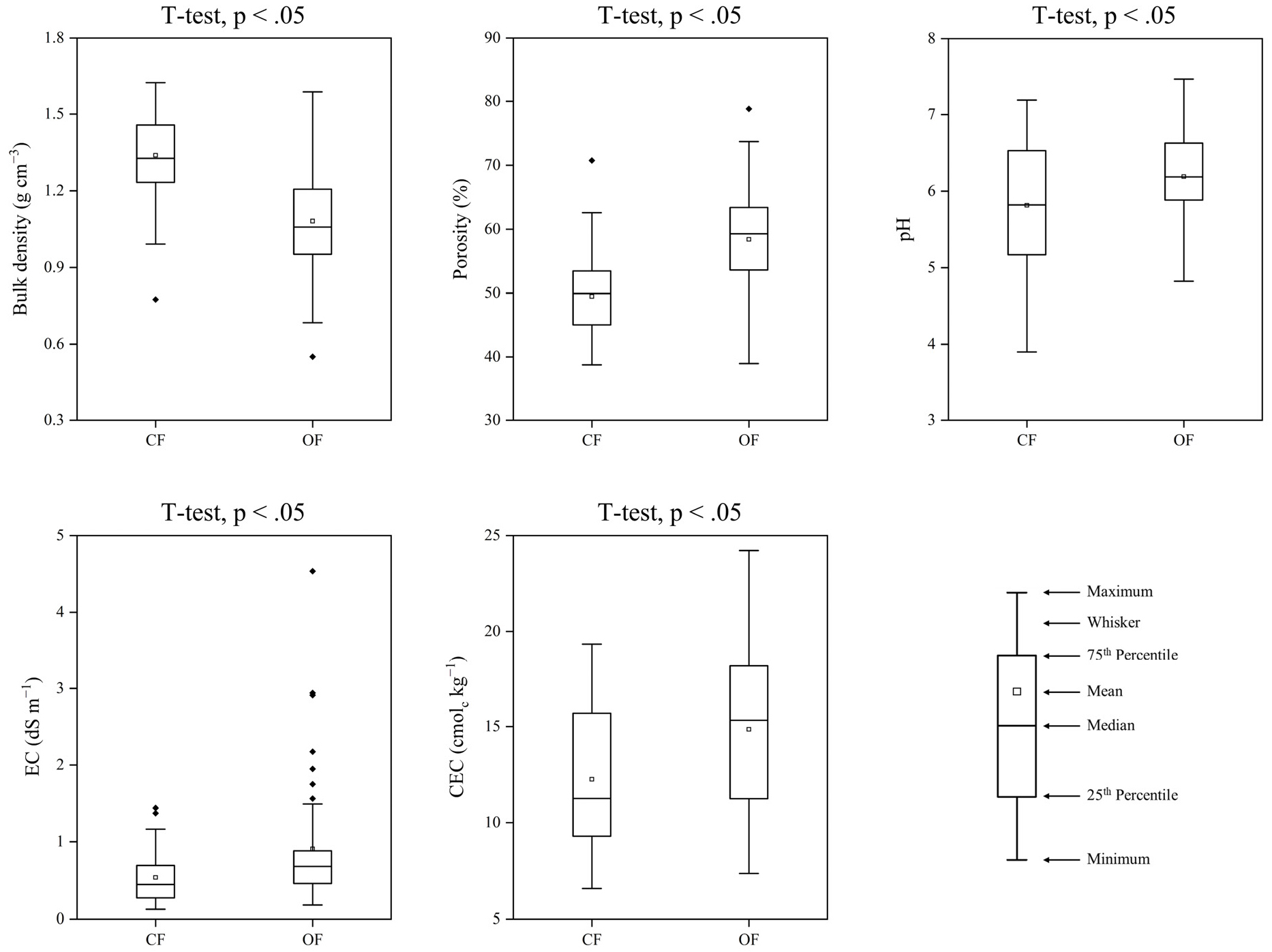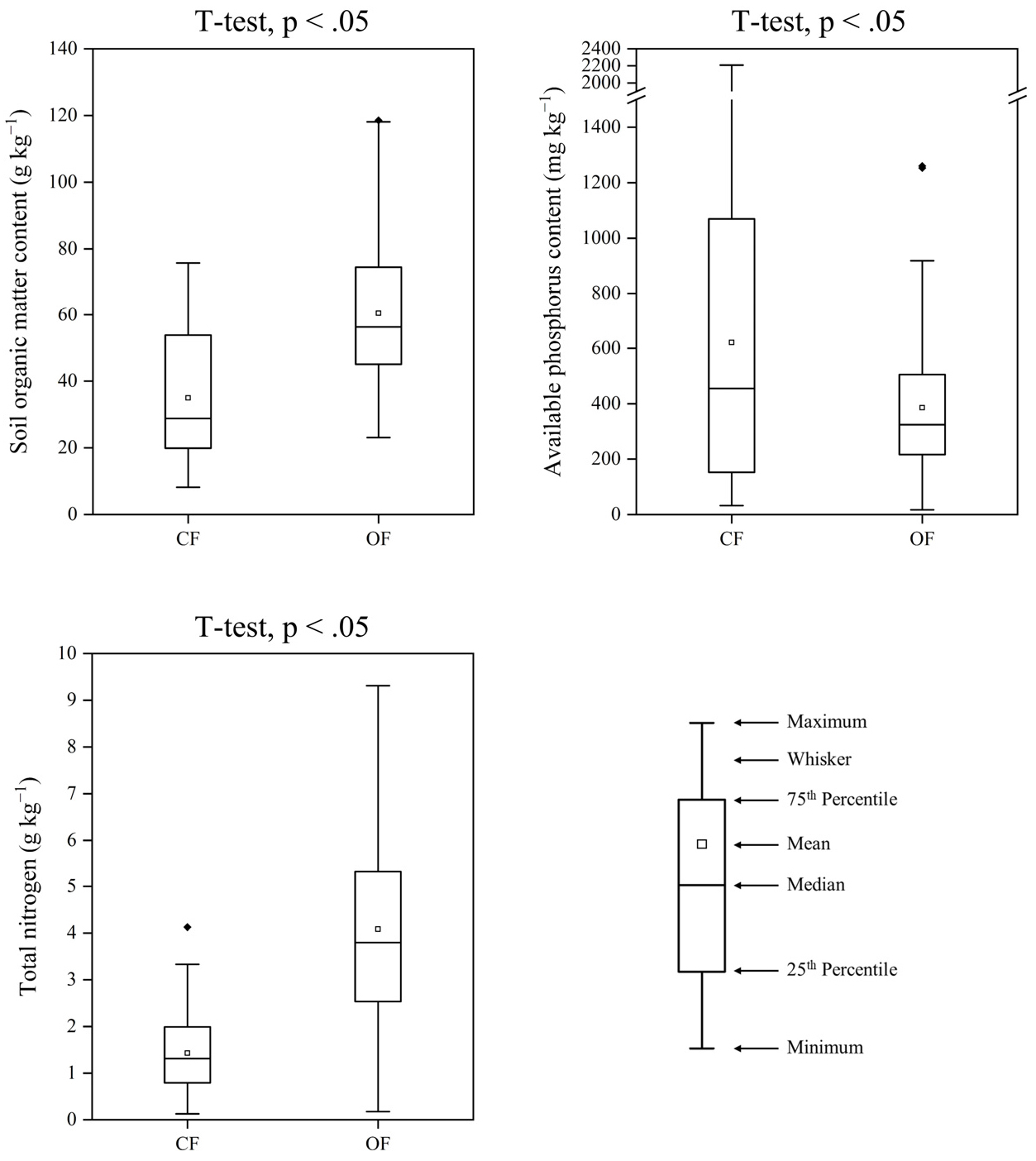Introduction
Materials and Methods
연구 지역 및 시료 채취
토양의 이화학성 분석
토양의 생물학적 특성 분석
통계 분석
Results and Discussion
토양의 물리적 특성 분석
토양의 화학적 특성 분석
토양의 생물학적 특성 분석
Conclusions
Introduction
20세기 후반 다양한 무기질 비료가 개발되었으며, 이들은 농작물 생산량 증가에 기여하였다 (Vitousek et al., 2009; Srivastav, 2020). 하지만 지속적인 무기질 비료의 사용으로 인해 현재 농업 환경에 부정적인 영향을 끼치고 있다 (Reboredo et al., 2019; Singh et al., 2020; Tripathi et al., 2020). 이들은 토양 내 장기간 잔류할 수 있으며, 첨가된 질소, 인 등으로 인해 토양 및 지하수를 오염시키고 (Gimeno-García et al., 1996; Sun et al., 2012), 토양 내 미생물 활성이나 군집의 다양성을 감소시킬 수 있다 (Zheng et al., 2019). 이처럼 무기질 비료를 사용하는 관행 농업의 여러 가지 문제점과 지속 가능한 친환경 농업 또는 친환경 농산물에 대한 수요의 증가로 전 세계적으로 무기질 비료나 농약을 사용하지 않는 유기 농업에 대한 관심이 증가하고 있으며 (Reddy, 2010; Seufert et al., 2017), 국내에서도 ‘친환경농업육성법’을 통해 유기 농업 활성화를 위해 다양한 정책을 시행하고 있다 (Lee et al., 2017). 무기질 비료를 사용하지 않으며 가축분뇨, 녹비작물, 미생물 등의 천연 유기질 비료를 사용하는 유기 농법은 토양 침식 감소, 유기물 함량 증가, 토양 미생물 다양성 및 활성 촉진 등 토양의 물리, 화학, 생물학적 특성에 영향을 미친다 (Hartmann et al., 2015; Ding et al., 2018; Seitz et al., 2019). 이처럼 토양에게 작용하는 유기 농업의 다양한 이점들로 인해 국내 유기 농경지를 대상으로 토양의 이화학적 및 생물학적 특성 분석에 대한 많은 연구가 진행되어 왔다 (An et al., 2015; Lee et al., 2020; Yi et al., 2020). 그러나 외국의 경우 수 십년간 무기질 비료를 사용한 농경지와 유기 농경지를 비교함으로써 농법에 따른 토양 침식 (Reganold et al., 1987), 토양 영양소 (Mondelaers et al., 2009; Hattab et al., 2019), 토양 미생물 (Lupatini et al., 2017)등 농업 환경에 미치는 특성들에 대한 비교 연구가 활발히 진행되고 있지만, 국내의 경우 대부분 각각 관행 농경지나 유기 농경지만의 토양 특성을 단편적으로 분석하고 있는 실정이다. 따라서 본 연구에서는 관행 농업을 실시한 밭 토양과 5년 이상 장기적으로 유기 농업을 실시한 밭 토양을 수집하여 이화학적 및 생물학적 특성을 분석하였으며, 관행 및 유기 농경지에서 다양한 토양 특성 간의 차이를 비교하였다.
Materials and Methods
연구 지역 및 시료 채취
본 연구를 위해 충청지역의 관행 농업 밭 50지점과 국립농산물품질관리원에서 5년 이상 유기농산물 인증을 받은 밭 50지점을 선정하여 토양 시료를 채취하였다 (Fig. 1). 토양 시료는 토양오염공정시험기준 ES 07130에 따라 토양 표면의 유기물층을 제거한 뒤 표토층 (0 - 15 cm)을 토양시료채취기 (soil auger)를 이용하여 채취하였다. 또한 토양 시료 채취 시 시료의 균질성을 위해 서로 다른 위치에서 시료를 채취 후 폴리에틸렌 백에 넣어 하나의 시료로 합쳐 충분히 섞은 후 아이스박스에 담아 실험실로 운반하였다. 토양의 이화학적 분석을 위해 수집된 토양을 105°C에서 12시간 건조 후 2 mm 표준체로 거른 뒤 사용하였으며, 토양의 생물학적 특성 분석에는 건조되지 않은 습토를 2 mm 표준체로 거른 뒤 사용하였다.
토양의 이화학성 분석
토양의 물리적 특성 중 용적밀도 및 공극률은 100 cm3 코어를 이용하여 토양을 채취한 뒤 105°C의 건조기에서 12시간 건조 후 건토의 무게를 측정하여 구하였다. 토양의 pH와 전기전도도 (electrical conductivity, EC)는 토양과 증류수를 1:5 (w/v)의 비율로 혼합한 뒤 30분간 진탕한 후 각각 pH meter (Orion StarTM A111, Thermo Fisher Scientific, Waltham, MA, USA)와 EC meter (SevenCompactTM Conductivity Meter S230, Mettler Toledo, Columbus, OH, USA)를 이용하여 측정하였으며, EC의 경우 측정값에 희석배수 (×5)를 곱하여 토양의 EC 값으로 사용하였다. 토양 유기물 함량 (soil organic matter, SOM) 및 유효인산 (available phosphorus, Av. P2O5) 함량 측정에는 각각 Walkley & Black법 (Walkley and Black, 1934)과 Bray No. 1 법을 적용하였으며, UV-Vis spectrophotometer (Uvmini-1240, Shimadzu, Kyoto, Japan)를 이용하여 비색 정량 하였다. 토양의 총 질소 (total nitrogen, T-N) 함량은 원소분석기 (TrueSpec CHN, LECO Corporation, St. Joseph, MI, USA)를 이용하여 분석하였다. 치환성 양이온은 토양을 1 N-NH4OAc로 추출하여 ICP-OES (iCAP 7000 Series, Thermo Fisher Scientific, MA, USA)를 이용하여 측정하였으며, 양이온 치환용량 (cation exchange capacity, CEC)은 Brown법을 이용하여 분석하였다 (Brown, 1943).
토양의 생물학적 특성 분석
토양 호흡량 분석은 Bottomley et al. (2020)을 참고하여 수행되었다. 토양 호흡량 분석을 위해 300 mL plastic bottle에 습토 100 g을 담은 후, 10 mL의 0.5 M NaOH를 20 mL glass vial에 넣고 bottle 안에 넣어준 후 밀봉하여 25°C에서 72시간 동안 배양하였다. 배양 후 0.5 M NaOH을 비커에 옮긴 후 phenolphthalein을 지시약으로 1.0 M HCl을 활용하여 보라색에서 무색으로 변할 때까지 적정 하였고, Bromocresol green을 지시약으로 0.2 M HCl로 푸른색에서 노란색으로 변할 때까지 적정하였다. 이때 소모된 0.2 M HCl의 양을 CO2 발생량으로 환산하여 토양 호흡량을 산출하였다. 토양 효소 중 Beta-glucosidase의 활성도를 측정하기 위해 Eivazi and Tabatabai (1988)의 분석법을 참고하였다. 먼저 토양 시료 0.5 g을 50 mL centrifuge tube에 담은 뒤 toluene 0.1 mL, citric phosphate buffer (pH 4.9) 1.5 mL, 초순수 0.9 mL, 50 mM ρ-nitrophenyl-nitrophenyl-D-glucopyranoside (PNG) 0.6 mL를 첨가하였다. 이후 배양기를 이용하여 30°C에서 1시간 배양하였으며, 배양이 완료된 뒤 Whatman No. 2 여과지를 이용하여 여과한 후 UV/Vis Spectrophotometer를 이용하여 400 nm 파장에서 흡광도를 측정하여 정량 하였다. 토양 내 dehydrogenase (DHA) 활성 분석을 위해 centrifuge tube에 토양 시료 6.0 g과 CaCO3 0.2 g을 첨가한 뒤 혼합하였다. 이후 2,3,5-triphenyltetrazolium chloride (TTC)와 증류수 2.5 mL를 넣어 혼합 후 밀봉하여 37°C에서 24시간 배양하였다. 배양이 완료된 뒤 methanol을 넣어 탈지면으로 막은 funnel에 혼합물을 탈지면의 붉은색이 없어질 때까지 지속적으로 methanol을 넣어주며 여과하였으며, 여과액은 methanol을 이용하여 100 mL까지 mass up한 뒤 485 nm에서 비색 정량 하였다 (Casida Jr et al., 1964). Phosphatase 활성 분석은 Tabatabai and Bremner (1969)의 실험 방법을 참고하였다. 먼저 centrifuge tube에 토양 시료 0.5 g과 toluene 0.1 mL를 첨가한 후 0.6 mL의 0.5 M Tris (pH 6.5), 1.8 mL의 초순수, 0.6 mL의 50 mM sodium-p-nitrophenyl phosphate (p-NPP)를 넣고 혼합한 뒤 30°C에서 1시간동안 배양하였다. 이후 8.0 mL의 ethanol을 넣은 뒤 Whatman No. 2 여과지를 이용하여 여과하였으며, 여과액에 2.0 mL의 2 M Tris를 넣은 후 400 nm에서 비색 정량 하였다. Urease의 활성도는 Kandeler and Gerber (1988)의 분석법을 참고하였다. 토양 시료 5.0 g을 100 mL 삼각 플라스크에 넣은 뒤 2.5 mL의 79.9 mM Urea를 가하여 37°C에서 2시간동안 배양시켰다. 배양이 완료된 후 KCl 30.0 mL과 초순수 2.5 mL를 첨가한 뒤 30분간 교반한 뒤 Whatman No. 2 여과지를 이용하여 여과하였다. 이후 여과액 1.0 mL, 초순수 4.0 ml와 0.3 M NaOH와 sodium salicylate solution을 혼합하여 조제한 시약을 5.0 mL 넣은 뒤 30분간 교반 하여 690 nm 파장에서 비색 정량하였다.
통계 분석
토양 시료의 이화학적 및 생물학적 특성 분석 실험은 3회 반복 수행하여 평균값으로 표시하였으며, 분석된 데이터의 평균 비교를 위해 statistical package for social science (SPSS) version 26.0 (SPSS Inc., Chicago, IL, USA)을 이용하여 독립표본 T 검정 (independent samples t-test)을 실시하였다.
Results and Discussion
토양의 물리적 특성 분석
토양의 용적밀도는 토양 구조와 같은 물리성을 나타낼 수 있는 지표이며, 토양의 공극률 (porosity), 수분 보유력 (water retention), 열용량 (heat capacity) 등을 측정하고 계산하는데 필수적이다 (Blake, 1965; Ruehlmann and Körschens, 2009). 용적밀도가 높을수록 토양 내 단위 용적당 고형 입자가 많아 공극률이 낮아지며, 이로 인해 토양의 투수성 및 배수성과 식물의 뿌리 신장률이 낮아지게 된다 (Håkansson and Lipiec, 2000; Neves et al., 2003). 토양 물리성 분석 결과 (Fig. 2) 관행 밭 토양의 용적밀도는 평균 1.34 g cm-3 (0.78 - 1.62 g cm-3)로, 유기농 밭 토양 (평균 1.08 g cm-3, 0.55 - 1.59 g cm-3) 보다 높은 것으로 분석되었으며 (p < .05), 토양 공극률은 관행 밭 토양 (49.5%, 38.8 - 70.8%)보다 유기농 밭 토양이 평균 58.4% (39.0 - 78.8%)로 더 높게 나타났다 (p < .05). 일반적으로 가축분뇨나 알팔파 (Medicago sativa L.) 등과 같은 녹비작물 (green manure)을 유기질 비료로서 시비하는 유기 농법은 토양 내 유기물 함량을 증가시켜 토양 입자 사이에 응집을 형성시키고, 용적밀도를 감소시킨다 (Wortman et al., 2012; Blanco-Canqui et al., 2015). 또한 유기 농법은 토양 내 내수성 입단 (water-stable aggregates)이나 투수성을 증가시키는 등 토양 물리성을 개선하는 효과가 있다 (Garcia et al., 2013; Williams et al., 2017). 또한 Fueki et al. (2012)의 연구에서 오랜 기간 유기 농법으로 경작된 토양에서 관행 농경지 토양보다 토양 내 대공극 (macropore)의 비율이 높았으며, 이로 인해 토양 투수성이 증가하였다고 보고하였다.
토양의 화학적 특성 분석
토양 내 다양한 화학적 특성 분석 결과는 Fig. 2 및 Fig. 3과 같다. 관행 및 유기농 밭 토양의 pH는 각각 3.90 - 7.19 및 4.82 - 7.46의 범위로 나타났으며 관행 밭 토양에서 더 낮은 pH 범위를 나타내었다 (p < .05). 일부 토양에서는 적정 pH 범위 (pH 5.5 - 6.5)보다 낮거나 높은 산성 및 염기성 토양이 존재하였지만 평균 pH가 5.81 (관행 농법) 및 6.19 (유기 농법)로 대부분 밭 토양의 적정 pH 범위를 만족하였다. 토양 EC의 경우 관행 및 유기농 밭 토양에서 각각 평균 0.53 dS m-1 (0.12 - 1.44 dS m-1) 및 0.91 dS m-1 (0.18 - 4.54 dS m-1)의 범위로 나타났다. 또한 토양 CEC는 관행 및 유기농 밭 토양에서 각각 평균 12.3 cmolc kg-1 (6.5 - 19.3 cmolc kg-1)로 및 14.9 cmolc kg-1 (7.3 - 24.2 cmolc kg-1)로 조사되어 유기 농경지에서 토양의 양이온 치환 용량이 다소 높은 것으로 나타났다 (p < .05).
이처럼 유기 농경지에서 토양의 pH, EC, CEC가 관행 농경지보다 높게 나타났는데, 이는 유기 농법에서 사용한 가축분 퇴비와 같은 유기질 비료 사용 때문인 것으로 판단된다. 일반적으로 가축분 퇴비의 시용은 토양 내 칼슘이온 (Ca2+) 및 마그네슘 이온 (Mg2+)과 같은 양분들을 증가시키며 (Yao et al., 2007; Ge et al., 2011), 동시에 토양의 pH 및 치환성 양이온과 CEC를 증가시킬 수 있다 (Gil et al., 2008a; Whalen et al., 2000; Moreira et al., 2015). 또한 유기질 비료를 지속적으로 시용 시 염류 집적으로 인해 토양 EC값이 증가할 수 있다 (Sohn et al., 1999; Eghball et al., 2004). 본 연구 결과에서도 적정 토양 EC값 (2.0 dS m-1)을 초과한 지점이 관행 밭 토양에서는 존재하지 않았지만, 유기농 밭 토양에서 3지점이 존재하였다.
또한 유기질 비료의 시용은 토양 내 유기물 및 총 질소 함량을 증가시킬 수 있다 (Tong et al., 2009; Byeon et al., 2022). 본 연구에서도 토양 유기물 함량은 관행 밭 토양에서 평균 35.0 g kg-1 (8.2 - 75.7 g kg-1), 유기농 밭 토양에서 60.8 g kg-1 (23.4 - 118.9 g kg-1)로 유기농 토양에서 더 높은 유기물 함량을 나타내었으며 (p < .05), 총 질소 함량도 유기 농경지에서 평균 4.08 g kg-1 (0.18 - 9.31 g kg-1)로 관행 농경지 (1.43 g kg-1, 0.13 - 4.12 g kg-1)보다 높게 조사되었다 (p < .05).
토양 내 유효인산 함량 분석 결과 관행 밭 토양에서 평균 620.8 mg kg-1 (32.6 - 2,207.4 mg kg-1)로, 유기농 밭 토양에서는 평균 488.7 mg kg-1 (72.6 - 1,260.5 mg kg-1)으로 나타났으며, 유효인산 함량은 관행 밭 토양에서 상대적으로 더 높은 것으로 분석되었다 (p < .05). 일반적으로 가축분 퇴비와 같은 유기 물질을 다량 시용하는 유기 농법은 인산의 집적으로 인해 토양 내 유효인산 농도가 높다고 보고되며 (Gil et al., 2008b; Tadesse et al., 2013; Lee et al., 2015), 본 연구 결과에서도 유기 농경지 중 농촌진흥청에서 제시한 유효인산 함량의 적정 범위 (350 - 500 mg kg-1)를 초과하는 지점이 총 21지점이 존재하였다. 또한 관행 밭 토양에서도 14지점이 적정 유효인산 범위를 초과하였는데, 이는 다량의 무기질 비료의 지속적인 시용으로 인해 토양 내 유효인산이 과량 집적된 것으로 보인다 (Wang et al., 2015).
토양의 생물학적 특성 분석
토양의 생물학적 특성 분석 결과를 Fig. 4에 나타내었다. 토양 호흡량은 토양 미생물 활동의 평가 지표로서 하기 위해 널리 사용되어 왔으며 (Alef and Nannipieri, 1995), 토양 온도, 수분 및 유기물 함량 등에 영향을 받는다 (Tang et al., 2006; Iqbal et al., 2009; Balogh et al., 2011). 본 연구에서 토양 호흡량은 관행 밭 토양에서 평균 46.9 CO2 mg kg-1 day-1 (14.7 - 112.4 CO2 mg kg-1 day-1)로, 유기농 밭 토양에서 평균 44.0 CO2 mg kg-1 day-1 (6.2 - 188.6 CO2 mg kg-1 day-1)로 나타났다. 지속적인 유기질 비료의 시용은 미생물 활동성과 군집의 다양성을 증가시킬 수 있으며 (Mäder et al., 2002; Srivastava et al., 2007), 관행 농경지와 비교하였을 때 유기 농경지에서 토양 호흡량이 상대적으로 더 높다고 보고된다 (Iovieno et al., 2009; Leskovar and Othman, 2018). 하지만 본 연구에서 관행 밭 토양과 유기농 밭 토양에서 토양 호흡량은 통계적으로 유의한 차이를 보이지 않았다 (p = .67). 이는 초기에 관행 및 유기 농경지에서 무기질 또는 유기질 비료의 형태로 투입된 유기 물질을 토양 미생물이 충분히 분해시킨 뒤인 정체기 (stasis phase)에 시료 채취 및 분석 (9 - 11월)을 수행하였기 때문에 농법별로 토양 호흡량이 비슷한 수준으로 분석된 것으로 판단된다 (Gunapala et al., 1998).
토양 효소는 토양의 생물학적 특성 및 토양 질 (quality) 평가 지표로 자주 이용되며 (Dick, 1994; Alkorta et al., 2003), 본 연구에서는 토양 내 4가지 토양 효소 (β-glucosidase, dehydrogenase, phosphatase, urease)의 활성을 분석하였다. β-glucosidase는 토양 내 cellulose 등의 유기물을 분해하는 효소 중 하나이며, 토양 내 탄소 (C) 순환 과정에서 중요한 역할을 하고 있다 (Turner et al., 2002). 또한 β-glucosidase는 토양질 및 토양 건강성의 평가지표로 사용되며 (Aon and Colaneri, 2001; Adetunji et al., 2017; Ozlu et al., 2019), 일반적으로 토양 내 유기물 함량 및 바이오매스 함량이 증가할수록 β-glucosidase 활성이 증가한다 (Lagomarsino et al., 2009; Aranda et al., 2015). 토양 내 β-glucosidase 활성 측정 결과 관행 밭 토양에서 평균 2.90 µmol PNP g-1 h-1 (0.61 - 6.50 µmol PNP g-1 h-1)으로, 유기농 밭 토양에서 평균 0.55 µmol PNP g-1 h-1 (0.06 - 1.03 µmol PNP g-1 h-1)으로 나타났다. Li et al. (2015)은 가축분 퇴비를 오랜 기간 동안 시용하면 토양 내 탄소 (C), 질소 (N), 인 (P)의 순환과 관련된 효소의 활성이 증가된다고 보고하였으며, Lupwayi et al. (2018)은 가축분뇨에 존재하는 다량의 유기 탄소로 인해 가축분뇨 시용량과 토양 내 유기탄소량 및 β-glucosidase 활성은 양의 상관 관계가 있다고 보고하였다. 하지만 본 연구 결과에서는 가축분 퇴비를 지속적으로 시용한 유기 농경지보다 관행 농경지에서 β-glucosidase 활성이 더 높았으며 (p < .05). 이는 관행 농경지에서 시비된 무기질 비료의 간접적인 효과, 즉 토양 내 양분 함량의 증가와 이로 인한 식물 뿌리 등과 같은 바이오매스의 증가 때문인 것으로 판단된다 (Böhme and Böhme, 2006). 또한 β-glucosidase 활성은 토양의 pH에 따라 변화할 수 있으며, 이들은 산성 토양에서 (Puissant et al., 2019; Wade et al., 2021) 높은 활성을 나타내기 때문에 유기 농경지보다 낮게 분석된 관행 농경지의 pH가 토양 내 β-glucosidase 활성을 증가시킨 것으로 추정된다.
Dehydrogenase는 토양 유기물의 생화학적 산화 과정에 필수적인 역할을 하며 (Ross, 1971), β-glucosidase와 마찬가지로 토양 유기물 함량이 증가할수록 활성이 높아진다 (Włodarczyk et al., 2002; Chun et al., 2021). 본 연구에서 dehydrogenase의 활성은 관행 밭 토양에서 평균 12.49 TPF µg-1 24 h-1 (1.48 - 39.32 TPF µg-1 24 h-1)으로 나타났으며, 유기농 밭 토양에서 평균 16.38 TPF µg-1 24 h-1 (0.76 - 110.60 TPF µg-1 24 h-1)으로 나타나 유기 농경지에서 더 높은 dehydrogenase의 활성을 보였으나 통계적으로 유의한 차이를 나타내지는 못하였다 (p = .17). 이처럼 β-glucosidase 및 dehydrogenase는 유기 농경지에서 토양 유기물 함량이 높았음에도 불구하고 관행 농경지보다 상대적으로 낮거나 비슷한 활성도를 보였다. 이러한 결과는 β-glucosidase 및 dehydrogenase의 활성이 토양 유기물 함량뿐만 아니라 토성, 점토 함량, 미생물 생체량 (microbial biomass)과 같은 다른 특성들과 심지어 토양 내 중금속, 농약 등과 같은 토양 오염물질에도 영향을 받을 수 있기 때문이다 (Beyer et al., 1993; Acosta-Martínez et al., 2007; Aponte et al., 2020).
토양 내 phosphatase의 활성은 관행 밭 토양에서 평균 13.27 µmol PNP g-1 h-1 (2.42 - 32.46 µmol PNP g-1 h-1)으로, 유기농 밭 토양에서 평균 6.60 µmol PNP g-1 h-1 (2.19 - 15.26 µmol PNP g-1 h-1)으로 나타났다. 토양 효소 중 하나인 phosphatase는 토양 내 유기인 (organic phosphorus)을 무기인 (inorganic phosphorus)으로 가수분해하여 식물이나 미생물이 이용할 수 있도록 가용화 (mineralization)하는 등 토양 내에서 인 (P)의 순환에 중요한 역할을 한다 (Tate, 1984; Chen, 2003). 이처럼 식물이나 미생물에 의해 생산되는 phosphatase는 토양 내 유효인산 함량을 증가시킬 수 있다 (Duff et al., 1994; Ghorbanzadeh et al., 2020). 또한 Liu et al. (2014)의 연구에 따르면 토양 내 질소 (N)의 첨가는 미생물의 phosphatase의 생산을 증가시킬 수 있으며, 이에 따라 토양 내 유효인산 (available phosphorous) 함량이 증가한다고 하였다. 본 연구 결과에서도 관행 밭 토양에서 유기농 밭 토양보다 높은 phosphatase의 활성을 나타내었으며 (p < .05), 관행 밭 토양에서 평균적으로 더 높은 유효인산 함량을 보였다 (Fig. 1). 이는 관행 농경지에서 질소 (N) 등이 포함된 무기질 비료의 지속적인 시용 때문인 것으로 판단된다.
Urease는 다양한 토양 미생물이나 식물로부터 생산되며 (Krajewska, 2009; Konieczna et al., 2012), 토양 내에서 질소 화합물인 요소 (urea)를 NH3나 CO2의 형태로 분해시킨다 (Mobley and Hausinger, 1989). 본 연구에서 urease 활성은 관행 밭 토양에서 평균 166.3 µg NH4-N g-1 2 h-1 (7.9 - 727.5 µg NH4-N g-1 2 h-1)으로, 유기농 밭 토양에서 평균 228.7 µg NH4-N g-1 2 h-1 (61.8 - 500.4 µg NH4-N g-1 2 h-1)으로 나타났다. 무기질 비료로 토양에 유입된 질소 (N)는 토양 내 urease의 활성을 높일 수 있으며, Zhong et al. (2007)의 연구에 따르면 장기적으로 무기질 비료를 통해 질소를 처리한 논 토양에서 질소를 처리하지 않은 토양보다 urease 활성이 증가하였다고 보고하였다. 또한 Wu et al. (2020)은 볏짚을 논 토양에 다시 환원할 경우 토양 내 유기물 함량 증가 등의 영향으로 인해 urease의 활성이 높다고 보고하였으며, 무기질 비료만 처리한 밭 토양보다 무기질 비료와 유기질 비료 (pig manure)를 함께 시용한 밭 토양에서 더 높은 urease의 활성을 보였다는 연구 결과가 존재한다 (Liu et al., 2018). 마찬가지로 본 연구 결과에서는 농법에 따른 urease의 활성은 유기농 밭 토양에서 더 높게 나타났으며 (p < .05), 이는 유기 농경지에서 더 높게 조사된 총 질소 함량에 따른 것으로 판단된다.
Conclusions
본 연구에서는 5년 이상 지속적으로 관행 및 유기 농법을 사용한 밭 토양의 이화학적 및 생물학적 특성을 비교하였다. 유기 농경지 토양은 관행 농경지보다 대부분 용적밀도가 낮고 공극률이 높아 토양의 투수성 및 통기성 등과 같은 물리적 특성에 더 유리할 것으로 판단된다. 유기질 비료를 지속적으로 시용한 유기 농경지에서는 pH, EC 및 CEC 값이 관행 농경지 보다 높게 조사되었다. 또한 관행 농경지에서 지속적으로 시비된 무기질 비료 등으로 인해 토양 β-glucosidase 및 phosphatase의 활성은 유기 농경지보다 더 높은 것으로 나타났으며, 유기 농경지에서는 urease의 활성이 더 높았다. 이처럼 관행 및 유기 농법에 따라 토양의 다양한 이화학적 및 생물학적 특성에서 차이를 보였으며, 지속가능한 농업을 위해서는 이러한 농법들이 토양에 미치는 영향들을 파악하여 관행 농법과 유기 농법 사이의 절충안이 필요하다고 사료된다.









